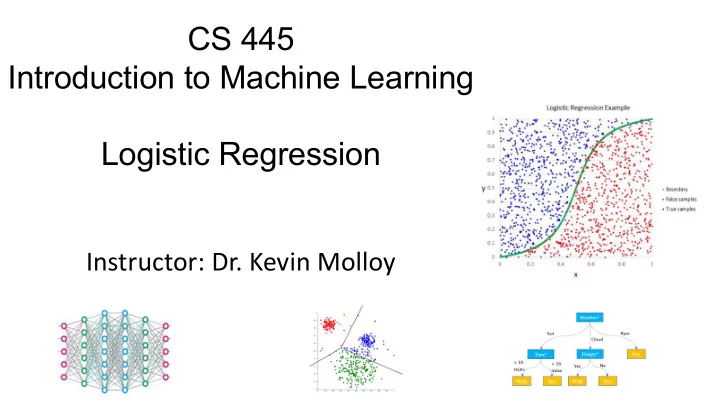

CS 445 Introduction to Machine Learning Logistic Regression Instructor: Dr. Kevin Molloy
Review Linear regression Finding the weights to assign to a polynomial so that the resulting line minimizes the "loss". ℎ(𝑦 ! , 𝑦 " , … 𝑦 # ) = 𝑥 $ + 𝑥 ! 𝑦 ! + . . +𝑥 # 𝑦 # ℎ 𝑦 = 𝑥 % 𝑦 This function h(x) (hypothesis function) makes a real valued prediction (regression). ! " ∑ # !, $ ! ∈& 𝑧 ' − 𝑥 ( 𝑦 ' " Linear Regression 𝑀 𝑥 =
Approach for Linear Regression ! ") ∑ # !, $ ! ∈& 𝑧 ' − 𝑥 ( 𝑦 ' " Linear Regression 𝑀 𝑥 = Optimize (find the min) of the loss function using the derivatives: 𝜖L(w) = 1 ()) (y ' − w + x ' ) N ) 𝑦 ' 𝜖w ! "#$..& 𝜖L(w) = 1 (y " − w + x " ) N ) 𝜖w $ "#$..&
Linear Regression Algorithm Make predictions using current w and compute loss 1. Compute derivative and update w's 2. When loss change is a little STOP, otherwise, go back to 1. 3.
Logistic Regression X X X X World's WORST algorithm name O O O O Transform linear regression into a classification algorithm h(x) >= 0.5, predict y = 1 (X class) h(x) < 0.5, predict y = 0 () class)
Map Function to Values Between 0 and 1 ! Sigmoid (z) = !" # #$ 1 1 + 𝑓 $% % &
Different Loss Function 1 1 + 𝑓 $% % & ! ") ∑ # !, $ ! ∈& 𝑧 ' − 𝑥 ( 𝑦 ' " Linear Regression 𝑀 𝑥 =
Cost Function for Linear Regression Loss( h ( x ), y ) = − log 𝑔 , 𝑦 𝑗𝑔 𝑧 = 1 − log 1 − 𝑔 , 𝑦 𝑗𝑔 𝑧 = 0
Cost Function for Linear Regression Loss( h ( x ), y ) = − log 𝑔 , 𝑦 𝑗𝑔 𝑧 = 1 − log 1 − 𝑔 , 𝑦 𝑗𝑔 𝑧 = 0 When y = 1: f(x) = 1, then Cost = 0 (since (-log(1) = 0) f(x) = 0 , then the loss (or penalty) will be very large.
Cost Function for Linear Regression Loss( h ( x ), y ) = − log 𝑔 , 𝑦 𝑗𝑔 𝑧 = 1 − log 1 − 𝑔 , 𝑦 𝑗𝑔 𝑧 = 0 When y = 0: f(x) = 0, then Cost = 0 (since (-log(1 –f(x)) = 0) f(x) = , then the loss (or penalty) will be very large.
Logistic Regression Loss Loss( h ( x ), y ) = − log 𝑔 , 𝑦 𝑗𝑔 𝑧 = 1 − log 1 − 𝑔 , 𝑦 𝑗𝑔 𝑧 = 0 . 𝑄 𝑧 = 1 𝑦 ) ) / ! 𝑦 𝑄 𝑧 = 0 𝑦 ) ) - 0 / ! Loss( h ( x ), y ) = ∏ )#-
Recommend
More recommend